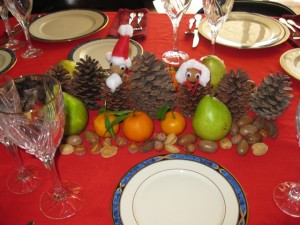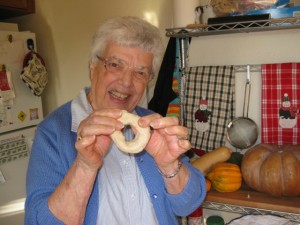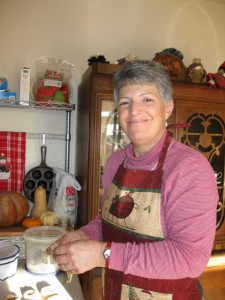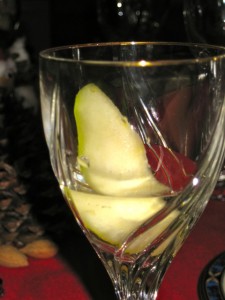I could go on and on and on about how fabulous my Christmas was this year. I really could. I think, instead, I’ll let the photos speak for me.

This is the little table arrangement I made. The cute pine cone Santa and Mrs. Claus were made by my in-laws.

After the dough is risen, we shape them. Doughnut shapes are plain, the skinny ones have alici -- anchovies!

Is this a spread or what? From left to right: plain cuduridi, alici pasta, smoked catfish, smoked salmon, alici cuduridi, marinated broccoli, and marinated cauliflower. (Salad is on the plates, as you'll see below.)

The salad is homegrown lettuce, kalamata olives, garlic, olive oil, and just a touch of hot pepper. The vino was one my folks brought that my aunt gave to them. It's fabulous.
Sadly, I have no pictures of the wonderful cannoli that my Grandma made. They were fabulous. They were so good they were gone before pictures could be taken. (; They were so good that the leftovers were gone before pictures could be taken!
Cuduridi is kind of an ongoing process. We’ve been doing it for so long, and we always change how we do it. It’s never the same way twice! Here’s what we did this year:
Cuduridi (Italian Fried Dough)
- 2 lb. white flour
- 1 lb. whole-wheat flour
- 5 1/2 tsp. rapid-rise yeast
- two generous pinches sugar
- 2 medium russet potatoes, peeled, chopped, boiled, and mashed
- cooking water from the potatoes
- canned flat fillets of anchovies, drained
- 3 quarts vegetable or corn oil for deep-frying
Scrub the potatoes, peel them, and chop them into medium-sized chunks. Place in a pot of boiling water and boil until the potatoes are soft. Scoop them out of the water and mash them. Reserve the cooking water for the dough.
While the potatoes are cooking, combine the flours, rapid-rise yeast, and sugar in a large bowl. Stir well to combine.
Add the potatoes and about two cups of the cooking water to the flour mixture. Stir well. The dough will start off stiff — add more water as needed until it’s at a kneadable consistency. Split the dough into at least two pieces to knead. Knead on a floured table or board until the dough springs back well when poked with a finger. You may need to add either more water or more flour to reach the right consistency.
Place the dough into two large greased bowls (cooking spray works fine), spray the top of the dough, and cover the bowls with damp kitchen towels. Set aside in a warm area to rise until the dough is doubled in bulk, about an hour and a half.
When the dough is risen, dust a table or counter with flour, and shape the dough, laying the pieces out on the floured surface. We traditionally use doughnut shapes for the plain ones, and long shapes for the anchovy ones. If you make anchovy cuduridi, be very careful not to get excess oil on the edges of the dough you wrap the anchovies in. If it gets oily, it won’t stick together properly, and the anchovy oil will get into your frying oil and cause a lot of spattering. Make large holes in the doughnut-shaped ones so that they do not rise back into a solid mass.
Let the cuduridi rise again, about half an hour to forty-five minutes. Meanwhile, prepare your deep-fryer by adding the oil and bringing the heat up to 350°F. I really do encourage everyone who’s reading this to use a deep-fryer when you do any deep-frying. They are much much safer and more stable than using a pan on the stove. The last thing you want is an ER trip on Christmas Eve, right? For the record, mine’s a DeLonghi, and I absolutely love it. We use it a few times a year.
Deep-fry the cuduridi, beginning with the plain ones, and ending with the anchovy ones. You do it this way so that when (not if) the anchovy ones leak, you don’t get anchovy flavor on your plain ones. Fry them on one side until golden brown, flip them over, and fry on the other side until golden brown. It doesn’t take more than a couple of minutes. Pull them off onto paper towels or paper bags to drain. Typically, we use a cardboard box lined with paper bags, but I totally forgot to hang onto one, so we lined a cooling rack with paper towels, and that worked just fine.
Take care biting into one, especially an alici one — they’re hot like lava! But totally worth it, and totally worth the effort. This recipe makes about 30 plain and 18 alici in one batch.










This brings back a lot of memories of my Grandmas Christmas!! Thanks!!!